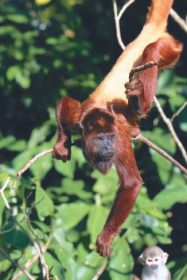Howling monkeys are a group of New World Monkeys (NWM) belonging to the subfamily Alouattinae and genus Alouatta. There are eight species of howling monkeys—the red-handed howler (Alouatta belzebul), black-and-gold howler (A. caraya), Coiba Island howler (A. coibensis), brown howler (A. fusca), mantled howler (A. palliata), black howler (A. pigra), red howler (A. seniculus), and the Bolivian red howler (A. sara). Howling monkeys are so named because of the loud territorial calls they make. The vocalizations are created by air being forced through a specialized, hollow hyoid bone. The resonance results in a loud, howling-like roar that can be heard up to 5 kilometers away.
 Howling monkeys are diurnal and live in a variety of forests in Central and South America. They can be found in tropical rain forests, secondary forests, montane forests, llanos forests, and dry deciduous forests. Males and females are sexually dimorphic, meaning that the males are bigger (4.5 kg-11.4 kg) than the females (3.1 kg-7.6 kg). Some species are also sexually dichromatic, with males and females having different color coats. Other species exhibit no obvious differences in hair color.
Howling monkeys are diurnal and live in a variety of forests in Central and South America. They can be found in tropical rain forests, secondary forests, montane forests, llanos forests, and dry deciduous forests. Males and females are sexually dimorphic, meaning that the males are bigger (4.5 kg-11.4 kg) than the females (3.1 kg-7.6 kg). Some species are also sexually dichromatic, with males and females having different color coats. Other species exhibit no obvious differences in hair color.
Howling monkeys have forelimbs and hindlimbs that are almost equal in length. They are arboreal and quadrupedal, moving slowly through the canopy. Howlers have prehensile tails that are used for suspensory behaviors, especially when feeding. The tail acts as a fifth limb, allowing howlers access to foods they normally might not be able to exploit without the help of the grasping tail. Their thumbs are almost absent, and thus they hold objects between their second and third fingers. This phenomenon is called “schizodactyly,” which literally means “between fingers.”
Howling monkeys are one of the most folivorous NWMs. They feed on leaves (both young and mature), fruits, flowers, buds, and petioles (stems that support the blades of a leaf). Since the majority of their diet is made up of leaves, howling monkeys have a special sacculated stomach in which the high amounts of cellulose in leaves are digested. Howlers also have large mandibles and specialized teeth indicative of their folivorous diet. They have shearing and grinding crests on their upper molars, which help them process the fibrous plant materials they consume.
Compared to other NWMs, howling monkeys have relatively small home ranges (4 ha-20 ha), with day ranges sometimes as short as 100 m. This could be due to their leafy diet, which does not afford them a lot of energy for traveling long distances. Howlers also spend a lot of time resting, possibly to conserve energy.
The social organization of howling monkeys varies by species. Red-handed howlers live in one male-multifemale groups, while mantled howlers have multimale-multifemale groups. The black-and-gold, Coiba Island, brown, black, red Bolivian, and red howlers have variable social structures. Some species consist of one male-multifemale and/or multimale-multifemale groups. The status of howling monkeys in the wild is variable. The International Union for Conservation of Nature and Natural Resources lists five species as Lower Risk, one species as Vulnerable, and two species at Critically Endangered due to habitat loss.
References:
- Fleagle, J. G. (1999). Primate adaptation and evolution. San Diego, CA: Academic Press.
- Milton, K. (1982). The foraging strategy of howler monkeys. New York: Columbia University Press.
- Reid, M. E. (2000). Howlers and other new world monkeys. Chicago: World Books.
- Rowe, N. (1996). The pictorial guide to the living primates. Charlestown, RI: Pogonias Press.
Like? Share it!
